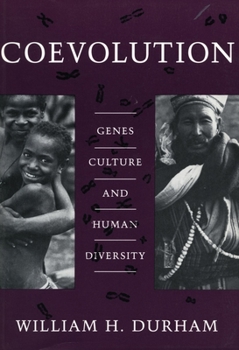Coevolution: Genes, Culture, and Human Diversity
Select Format
Select Condition 
Book Overview
A Stanford University Press classic.
Format:Paperback
Language:English
ISBN:0804721564
ISBN13:9780804721561
Release Date:January 1991
Publisher:Stanford University Press
Length:656 Pages
Weight:2.24 lbs.
Dimensions:1.6" x 6.1" x 9.0"
Customer Reviews
2 ratings
Good but a bit too detailed
Published by Thriftbooks.com User , 15 years ago
Trying to understand how culture and genetics interact is an important area and it's about time that more people comprehend that it's not "nature or nurture" but "nature and nurture". However, in trying to cover all the bases of the origins of modern theory and the breadth of the state of research, I think the author got a bit lost in the complexity of the issue and tried to cover too much. I look for books such as this to be better than pop culture but less than an academic treatise. For me, the book shaded too much to the later. That wasn't the big problem though, rather the combination of breadth, depth and lack of clarity failed to keep my interest. It's a good attempt and look forward to following the issue as it evolves... ;)
This is a classic, but still completely up to date
Published by Thriftbooks.com User , 20 years ago
In humans, both genes and culture are containers of information passed from one generation to the next. Both genes and culture affect the phenotype, and therefore individual behavior. It follows that both genes are culture are subject to Darwinian selection. In addition, genes are part of the environment in which culture evolves, and culture is part of the environment in which genes evolve. Of course, the physical representation of genes and culture are very different. Genetic information is coded in DNA, while cultural information is coded in the synaptical structure of the brain. Moreover, Fisher's fundamental theorem, which says fitness tends to increase, is true for a single genetic locus, but not for a single culture locus, since agents can sustain an increase in a fitness-decreasing meme. Durham uses the term 'meme' for a unit of cultural inheritance. I think his defense of this is one of the strongest points in this great book. He shows that culture cannot be identified with phenotype or behavior. It follows that we must drop the term 'geno-phenotype'. In its place we can use the term 'geno-memotype.' Variants at a cultural locus are called allomemes by Durham. Good choice.We have learned much about brain functioning, the role of emotions, autism and sociopathy, and human altruism since this book was published (1991), and Durham uses no math, which I always thought a necessary part of gene-culture coevolutionary theory. Neither of these is a drawback, and indeed the fact that he produces a brilliant model of coevolution without the usual mathematical tools is a true tour de force!Durham provides extended analyses of Tibetian marriage patterns, lactose tolerance, sickle-cell anemia, and disease transmitted by cannibalism. These are standards of the trade now, but Durham's analysis are absolute gems, even if you know the literature on the topic.






